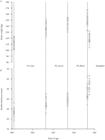ABSTRACT
We investigated the ability to predict production performance in Iberian pigs in an extensive production system from measurements of feed efficiency measured intensively. The second objective of this work was to study the relationship between feed efficiency and meat quality (composition, juiciness, tenderness, color, and subcutaneous fatty acid composition) and if cooked and cured quality properties can be predicted by properties in fresh meat. Thirty Iberian sows received successively a restricted diet of concentrate (P1concentrate) and acorns (P2acorn) intensively and an ad libitum diet of acorns supplemented with a restricted amount of concentrate (P3montanera) extensively. Pigs that were more feed efficient on concentrate were less feed efficient on acorns and had higher body weight gain during the montanera . Improved feed efficiency on acorns reduced the concentration of α-linolenic and linoleic fatty acid composition of subcutaneous fat. Faster body weight gain in montanera resulted in a desirable reduction in cooking loss and a reduction in palmitic acid content in subcutaneous fat, and a potentially undesirable reduction in meat redness. Tenderness in cooked or cured loin was not significantly related to tenderness in the raw product. Cooking loss was positively related to purge and centrifugal drip loss and to color coordinates a*24 and b*24 in raw samples. We conclude that feed efficiency and body weight gain may be improved in the traditional Iberian production system, with a positive effect on cooking loss but potentially resulting in paler meat.
Keywords:
correlation; fatty acids; feed intake; meat quality; montanera; pig production

 Thumbnail
Thumbnail
